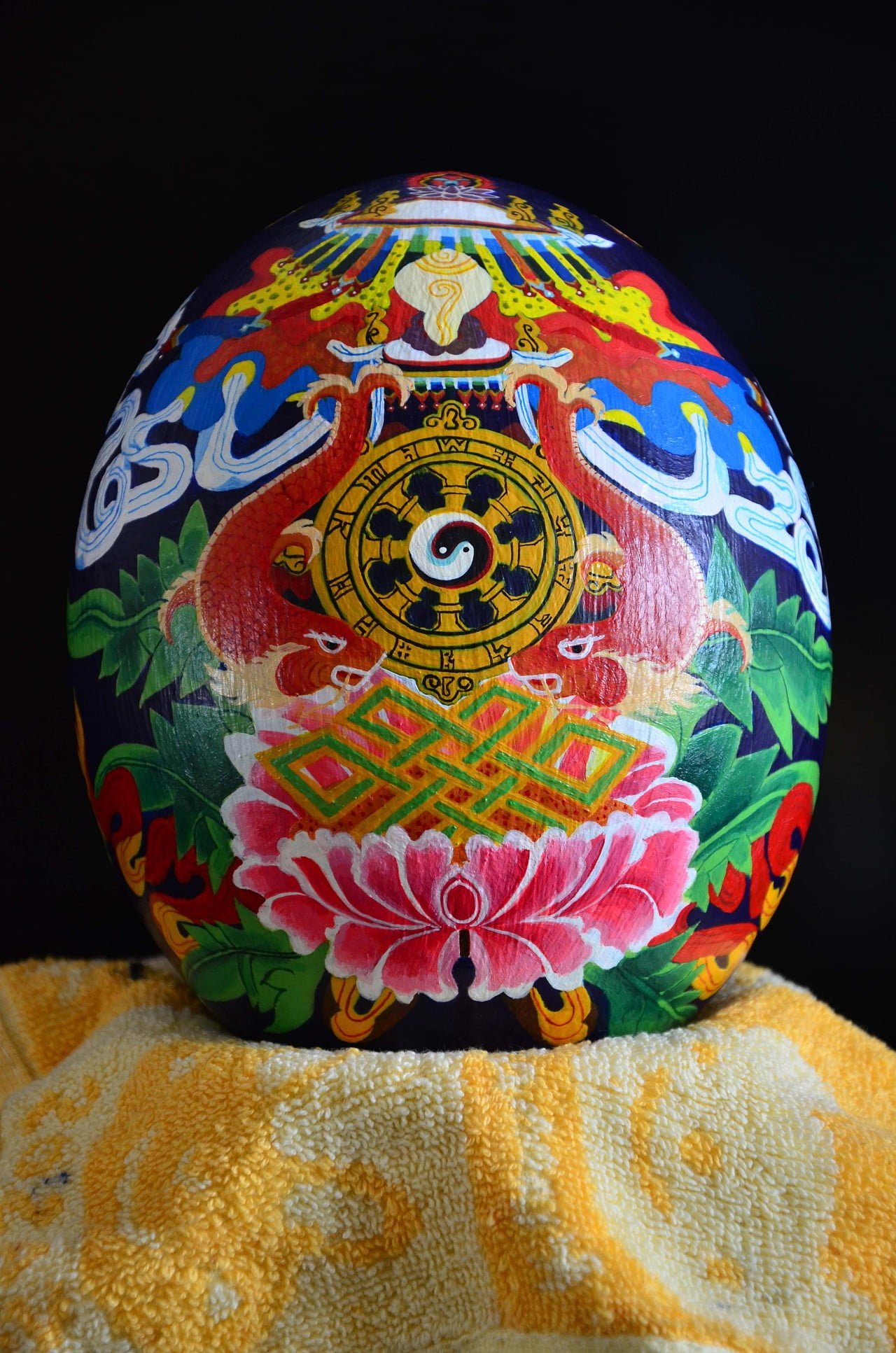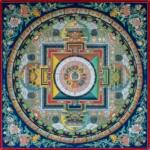Tibet, a land shrouded in mystery and antiquity, boasts a culture rich in allure, spirituality, and artistry. Among its cherished symbols, widely revered and worshiped, lies the auspicious eight symbols known as the “Eight Auspicious Symbols,” symbolizing fortune, auspiciousness, and prosperity within Tibetan Buddhism.
The Eight Auspicious Symbols encompass: the Lotus, the Vase, the Golden Fish, the Dharma Wheel, the Victory Banner, the Knot of Eternity, the Parasol, and the Conch Shell. These symbols not only embody the eight wisdom of Buddhism but also reflect humanity’s aspirations for a harmonious and prosperous life.
The Significance of Each Symbol:
- The Lotus: Symbolizing purity and rebirth, the Lotus is revered in Buddhism as a representation of purity and enlightenment, emerging unsullied from the muddy waters, urging individuals to transcend worldly afflictions and seek inner purity and awakening.
- The Vase: Representing wealth and abundance, the Vase brims with the nectar of prosperity and happiness, encouraging individuals to cherish every moment in life and pursue contentment and fulfillment.
- The Golden Fish: Symbolizing health and peace, the Golden Fish gracefully navigate the waters, embodying vitality and well-being. They also signify peace and auspiciousness, advocating for the appreciation of life and the pursuit of a healthy and peaceful existence.
- The Dharma Wheel: Signifying wisdom and equality, the Dharma Wheel is a prominent symbol in Buddhism, representing the dissemination of Buddhist teachings and the power of wisdom. It also symbolizes equality and justice, advocating for the pursuit of wisdom and equality in society.
- The Victory Banner: Symbolizing triumph and achievement, the Victory Banner is a symbol of victory in Buddhism, signifying the conquest of afflictions and obstacles. It also symbolizes accomplishment and success, encouraging individuals to strive for victory and achievement in life.
- The Knot of Eternity: Symbolizing harmony and auspiciousness, the Knot of Eternity represents happiness and auspiciousness. It also symbolizes harmony and unity, urging individuals to pursue a harmonious and auspicious life.
- The Parasol: Symbolizing protection and refuge, the Parasol is a symbol of auspiciousness and protection. It also symbolizes protection and shelter, advocating for the pursuit of protection and refuge in life.
- The Conch Shell: Representing the power of speech, the Conch Shell symbolizes the voice of the Buddha, capable of spreading teachings and wisdom. The sound of the conch shell is considered pure and sacred, capable of purifying the mind and guiding direction.
The Role of the Symbols in Tibetan Culture:
The belief in and practice of the Eight Auspicious Symbols play a significant role in Tibetan religious ceremonies and daily life. For example, in Buddhist temples, these symbols are often depicted in murals, thangkas (religious scroll paintings), and statues. They also adorn the roofs, doors, and other structures of temples as decorations.
Moreover, the Eight Auspicious Symbols are often crafted into various items such as sculptures, ornaments, jewelry, and patterns on clothing, to be worn or displayed in homes for auspiciousness and protection. For instance, some Tibetan families hang knots of eternity woven with gold or silver threads on windows or place miniature models symbolizing victory banners in their homes to pray for family harmony and career success.
The Spiritual and Cultural Essence of the Eight Auspicious Symbols:
The belief in and practice of the Eight Auspicious Symbols reflect the Tibetan people’s aspirations for a better life and their reverence for Buddhist teachings. They are not only symbols of religion but also integral elements rich in meaning and symbolism within Tibetan culture.
The faith and practice surrounding the Eight Auspicious Symbols are deeply rooted in Tibetan and neighboring cultures, transcending religious realms to become intertwined with daily life. They represent a fusion of spirituality, aesthetics, and cultural identity, embodying the aspirations of the Tibetan people for happiness, health, peace, and prosperity, as well as their pursuit of cosmic harmony and balance.
The symbol can be found in the art of most schools of Buddhism, especially in Tibetan Buddhism.

Origins
- The eight auspicious symbols of Buddhism originated in Indian iconography.
- In ancient times, many of these same symbols were associated with the coronations of kings.
- In Buddhist legend, the symbol represents offering the gods made to the Buddha after his enlightenment.
1 Two golden fish
The two fish were originally symbolic of the rivers Ganges and Yamuna but came to represent good fortune in general, for Hindus, Jain, Buddhists. Within Buddhism it also symbolizes that living beings who practice dharma need have no fear to drown in the ocean of suffering, can freely migrate (chose their rebirth) like fish in the water.
2 Conch shell
In Asia, the conch has long been used as the battle horn. The Hindu epic the Mahabharata, the sound of hero Arjuna’s conch terrorized his enemies. In ancient times a white conch also represented the Brahmin caste to Hindus. With Buddhism, a white conch that coils to the right represents the sound of Dharma reaching far and wide, awakening beings from ignorance.
3 Lotus Flower
The lotus is rooted in deep mud and its stem grows through murky water. But the blossom rises above the muck and open in the sun, beautiful and fragrant. In Buddhism, the lotus represents the true nature of beings, who rise through samsara into the beauty and clarity of enlightenment. It symbolizes the complete purification of the defilement of body, speech, and mind.
4 Endless Knot
The eternal knot, with its lines flowing and entwined in a closed dependent origination and the interrelation of all phenomena. It also signifies cause and effect and the union of compassion and wisdom. It represents the union wisdom and method, and at the time enlightenment, the complete union of wisdom and great compassion.
5 The Vase
The treasure vase is filled with precious and sacred things, yet no matter how much is taken out. It is always full. The Vase represents the teaching of the Buddha, which remained a bountiful treasure no matter how many teachings he gave to others. It also symbolizes long life and prosperity.
6 Banner of Victory
The victory banner signifies the Buddha’s victory over the demon Mara and over what Mara represents passion, fear of death, pride and lust. More generally, it represents the victory of wisdom over ignorance. There is a legend that the Buddha raised the victory banner over Mount Meru to mark his victory over all phenomenal things.
7 The Parasol
A symbol of royal dignity and protection from the heat of the sun. by extension, it represents protection from suffering. It is usually depicted with a dome, representing the compassion. Sometimes the dome is octagonal representing Eight-fold Path or square, representing the four directional quarters.
8 Dharma Wheel
The Dharma Wheel also called the dharma-chakra or Dhamma Chakka is one of the most well-known symbols of Buddhism. The Wheel has eight spokes, representing the Eightfold Path. According to tradition, the Dharma Wheel was first turned when the Buddha delivered his enlightenment.
















